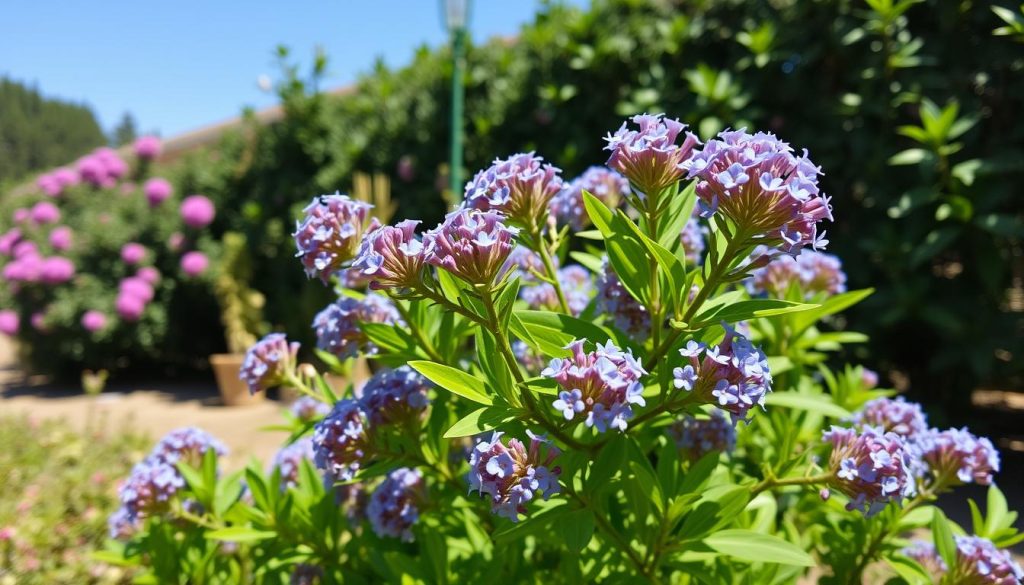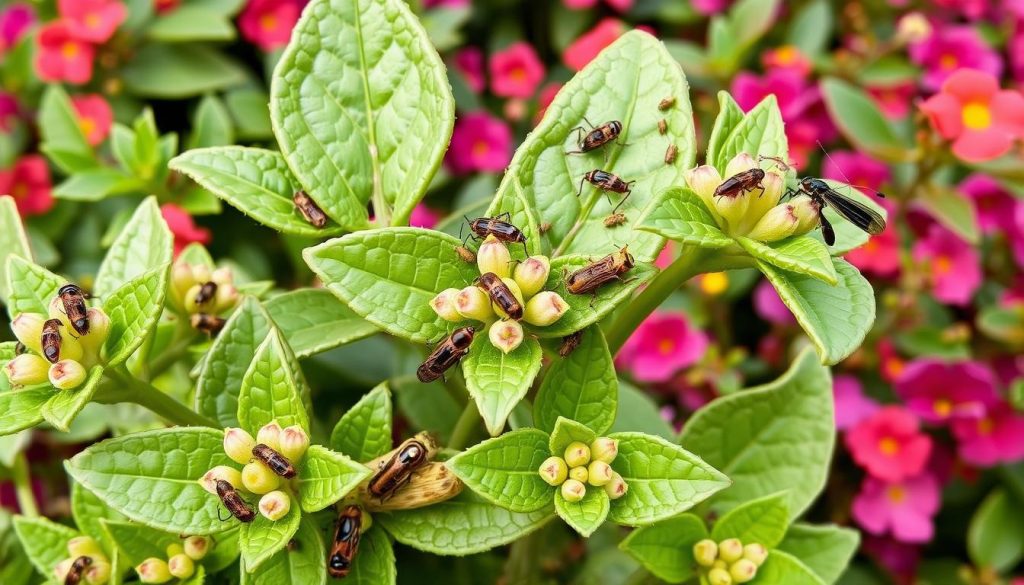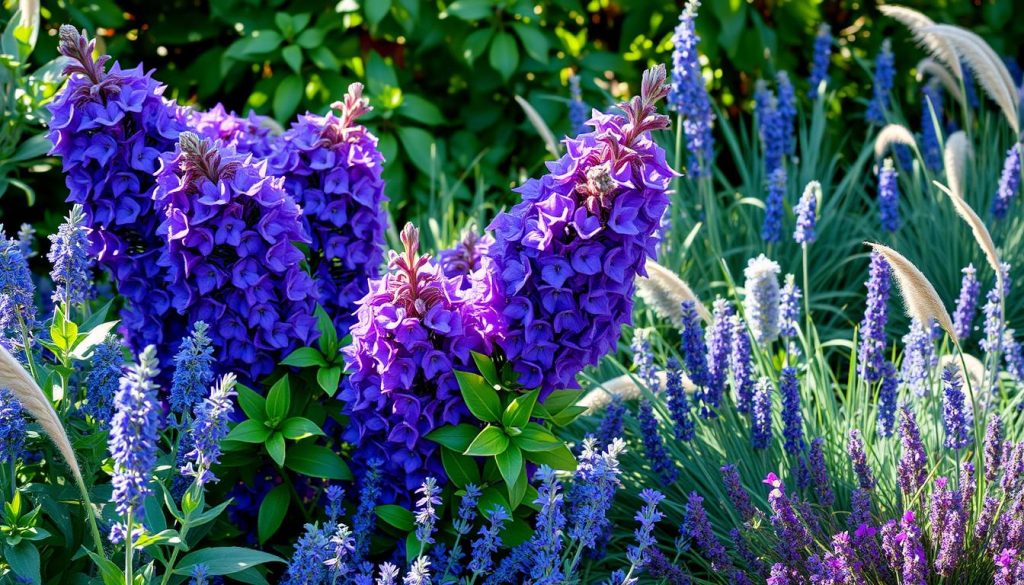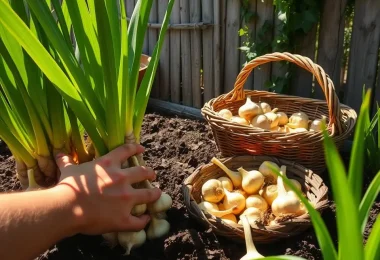Ceanothus, or California lilac, is a stunning shrub that brings colour and texture to UK gardens. This guide is perfect for both experienced gardeners and beginners. It will teach you how to grow and care for Ceanothus successfully.
We’ll cover everything from picking the right variety to mastering watering and pruning. You’ll learn how to cultivate this versatile plant in your garden.

Key Takeaways
- Ceanothus is a hardy, drought-tolerant shrub native to the western United States and Canada
- Choosing the right Ceanothus variety for your garden’s climate and soil conditions is crucial for success
- Proper planting, watering, and pruning techniques are essential for maintaining the health and appearance of Ceanothus
- Ceanothus can be propagated through cuttings or seeds to expand your garden collection
- With the right care, Ceanothus can thrive in containers or as part of a larger landscape design
Introduction to Ceanothus
Ceanothus, also known as California lilac, is a stunning genus of flowering shrubs from North America. These plants are loved for their clusters of small, fragrant flowers in colours like blue, purple, white, and pink. With many Ceanothus varieties, you can find the ideal ceanothus shrub for your garden.
What is Ceanothus?
Ceanothus is a group of about 50 to 60 species of shrubs and small trees. They belong to the buckthorn family, Rhamnaceae. These plants are known for being tough and adaptable, making them great for gardens that need little care.
Varieties of Ceanothus
The Ceanothus genus has a wide range of varieties. Each one has its own special features:
- Evergreen Ceanothus: These keep their leaves all year, creating a beautiful background for their flowers.
- Deciduous Ceanothus: These shed their leaves in winter, showing off their interesting branch patterns.
- Compact Ceanothus: Perfect for small gardens, they grow neatly and can be used as ground covers or hedges.
- Trailing Ceanothus: These varieties spread out, great for hanging over walls or down banks.
With so many ceanothus varieties to choose from, you can pick the perfect one for your garden. Whether you want a bold statement, a low-growing cover, or a trailing plant, there’s something for everyone.
“Ceanothus is a versatile and beautiful shrub that deserves a prominent place in any garden.”
related: How to Plant and Care for Dahlias: Tips for a Lush Garden
Choosing the Right Ceanothus for Your Garden
When picking a ceanothus for your UK garden, think about its size, what it likes to grow in, and the colour and timing of its flowers. With so many ceanothus varieties out there, picking the right one is key to a beautiful garden.
For those with small spaces, look at the compact ceanothus varieties. They add colour without taking up much room. On the other hand, the bigger, spreading types make a stunning focal point in your garden.
It’s important to choose a ceanothus that fits your garden’s conditions. Some need full sun, while others do well in shade. Also, some prefer well-drained, slightly acidic soil, while others are more adaptable.
The ceanothus family comes in a wide range of colours, from soft whites to bright blues, purples, and pinks. Picking a variety that matches your garden’s colours can make it look even more beautiful.
By doing your research and thinking about what you need, you can find the perfect ceanothus for your UK garden. Enjoy the beauty and benefits of this amazing shrub.
“Ceanothus are a wonderful addition to any garden, providing a burst of colour and attracting pollinators throughout the growing season.”
Planting Ceanothus
Ceanothus, a vibrant and resilient shrub from North America, needs careful planting. Choosing the right site and preparing the soil are key. These steps help the plant grow well in your garden.
Site Selection
Ceanothus loves well-drained, slightly acidic soil and lots of sunlight. Find a spot that gets at least 6 hours of direct sunlight daily. Steer clear of areas with poor drainage or heavy clay soil, as ceanothus hates wet feet.
Soil Preparation
Preparing the soil is vital for a healthy start. Dig the soil 12-18 inches deep and mix in compost. This improves drainage and adds nutrients, helping the roots grow strong.
When planting, make the hole twice as wide as the root ball. Plant at the same depth as the nursery container. This ensures the roots get the right depth for nutrients and water.
“Ceanothus is a versatile and resilient shrub that can thrive in a wide range of garden settings, provided the soil and sunlight conditions are right.”
Ceanothus Care
Keeping your ceanothus shrubs healthy involves the right balance of watering and pruning. These steps are key to making sure your plants flourish. They will add beauty to your garden with their vibrant leaves and lovely flowers.
Watering
New ceanothus need regular watering to grow strong roots. Keep the soil moist during the first few months. But, don’t overdo it. Once they’re settled, they can handle some dry spells without much water.
Pruning
Pruning is vital for ceanothus care. It keeps the plant looking neat and encourages new growth. Prune in late winter or early spring, just before new leaves and flowers start to appear.
When you prune, take out any dead, damaged, or tangled branches. You can also shape the plant to fit your style. Just remember, don’t cut into the older, woodier parts. It can harm the plant.
| Watering Guidelines | Pruning Recommendations |
|---|---|
| Newly planted ceanothus: Water regularly to keep soil moist Established ceanothus: Water only during prolonged dry spells Avoid overwatering at all stages | Prune in late winter or early spring Remove dead, damaged, or crossing branches Shape the plant as desired, but avoid cutting into older, woody growth |
By sticking to these watering and pruning tips, your ceanothus will stay healthy and look great. They’ll be a joy in your garden for many years.
Ceanothus Propagation
Propagating ceanothus is a fun way to grow more of this lovely garden plant. You can use different methods to create new plants. Each method has its own benefits.
Softwood and Hardwood Cuttings
One of the best ways to grow ceanothus is by using softwood or hardwood cuttings. Take these in the spring or summer. Cut off healthy tips, remove lower leaves, and dip in rooting hormone powder.
Plant the cuttings in moist potting mix. Keep the soil wet until roots grow, which takes 4 to 8 weeks.
Seed Sowing
Another way to grow ceanothus is by sowing seeds. This method takes longer. The best time is autumn, as seeds need cold to germinate.
Sow seeds in a tray or container with moist seed-starting mix. Wait for seedlings to appear, which can take weeks.
| Propagation Method | Timing | Success Rate | Time to Maturity |
|---|---|---|---|
| Softwood/Hardwood Cuttings | Spring/Summer | High | 4-8 weeks |
| Seed Sowing | Autumn | Moderate | 6-12 months |
Choosing the right method for ceanothus propagation is important. Patience and care are crucial for success. With the right approach, you can enjoy these beautiful shrubs in your garden for many years.
Common Pests and Diseases
Ceanothus, a vibrant and versatile shrub, can face pests and diseases. Gardeners must watch out and tackle problems early. This keeps these plants healthy and vibrant.
Identifying and Treating Pests
Aphids are a common pest for ceanothus. These tiny insects suck sap, causing stunted growth and distorted leaves. Organic pest control like insecticidal soap or neem oil can help get rid of them.
Spider mites also trouble ceanothus. They eat the leaves, making them discoloured and mottled. To fight them, mist the leaves regularly and use horticultural oils.
Preventing and Managing Diseases
Root rot is a fungal disease that can harm ceanothus. Good soil drainage and not overwatering are key to prevent it. Applying a fungicide to the soil can also help.
Powdery mildew and leaf scorch are other diseases ceanothus may get. Good air circulation and plenty of sunlight can reduce these risks. If a problem happens, remove affected leaves and treat with a fungicide.

By being alert and acting fast, gardeners can keep their ceanothus plants healthy. This ensures they continue to brighten up outdoor spaces.
Growing Ceanothus in Containers
Ceanothus is a stunning shrub with vibrant flowers. It can grow well in containers, perfect for small gardens. With a few tips, you can bring beauty to your patio or balcony.
For growing ceanothus in pots, choose a potting mix made for shrubs and trees. This mix helps the roots breathe and stay moist. Make sure your pot has lots of holes to avoid waterlogging.
It’s important to pick a big enough pot for your ceanothus. As it grows, it needs room for its roots. Go for a pot that’s at least 18 inches wide and deep.
Keep your ceanothus watered and fertilised regularly. In the growing season, keep the soil moist but not too wet. Use a slow-release fertiliser in spring to help it grow well and bloom.
With the right care, ceanothus can flourish in containers. It adds colour and greenery to even the smallest gardens. Follow these tips to enjoy this beautiful shrub in your outdoor space.
Ceanothus Companion Plants
Pairing Ceanothus with the right plants can make your garden look amazing. Ceanothus, a type of evergreen shrub from North America, loves well-drained soil and full sun. It’s perfect for gardens that need little care and can handle dry spells.
To match the bright blue or white flowers of Ceanothus, consider these plants:
- Lavender (Lavandula spp.): Its fragrant purple or blue flowers look great with Ceanothus.
- Rosemary (Rosmarinus officinalis): This herb’s delicate blue or white flowers and scent go well with Ceanothus.
- Sage (Salvia spp.): Sage comes in many colours, from purple to white, and looks stunning with Ceanothus.
- Ornamental Grasses: Grasses like Festuca or Stipa add texture and movement to your garden.
Choosing plants that grow well together makes your garden look better. It also helps your garden be healthier and more diverse. This way, your garden becomes a beautiful place that’s good for the environment.
| Companion Plant | Characteristics | Complementary Features |
|---|---|---|
| Lavender (Lavandula spp.) | Drought-tolerant perennial, fragrant purple or blue flowers | Colour and fragrance complement Ceanothus blooms |
| Rosemary (Rosmarinus officinalis) | Aromatic herb, blue or white flowers | Foliage and flower colours pair well with Ceanothus |
| Sage (Salvia spp.) | Diverse range of purple, blue, and white flowering varieties | Contrasting flower colours enhance the Ceanothus display |
| Ornamental Grasses | Feathery and low-growing, such as Festuca or Stipa | Add texture and movement to the Ceanothus-based garden |

Adding these plants to your garden makes it not only beautiful but also healthy and diverse. It’s a great way to show off Ceanothus while making your garden better for all living things.
Ceanothus in Landscaping
Ceanothus, also known as California lilac, is great for UK gardens. These shrubs come in different shapes and colours. They add interest and texture to your garden.
Think about the size and shape of each ceanothus when planning your garden. Small, spreading types are good for borders or ground cover. Larger ones are perfect for hedges or as standout plants.
- Ceanothus ‘Concha’ is great for low-growing ground cover in rock gardens or along paths.
- Ceanothus ‘Skylark’ is perfect for hedging or screens with its dense, rounded shape.
- Ceanothus ‘Joyce Coulter’ has bright blue flowers and a tall, tree-like shape. It’s a beautiful garden feature.
| Ceanothus Variety | Growth Habit | Flower Colour |
|---|---|---|
| Ceanothus ‘Concha’ | Compact, spreading | Deep blue |
| Ceanothus ‘Skylark’ | Rounded, dense | Sky blue |
| Ceanothus ‘Joyce Coulter’ | Upright, tree-like | Bright blue |
You can pair ceanothus with plants like lavender, rosemary, and thyme. This creates beautiful, Mediterranean-style garden designs.
“Ceanothus is a versatile and eye-catching addition to any British garden, offering a range of growth habits and vibrant flower colours to enhance the landscape.”
Harvesting and Using Ceanothus
Ceanothus is not just for looks; it’s also useful. You can pick its flowers for fresh or dried arrangements. The leaves and stems make great natural dyes for your textiles and crafts.
Some Ceanothus species have edible berries. You can make jams, jellies, and more with them. Ceanothus is perfect for brightening your home, adding flair to DIY projects, or making tasty treats.
Harvesting Ceanothus Flowers
Ceanothus flowers come in colours like indigo and white. To pick them, cut the flower clusters from the stem. This way, the plant can keep growing. You can use the flowers right away or dry them for later.
Using Ceanothus Leaves and Stems for Dyes
- Collect Ceanothus leaves and stems, making sure they’re clean.
- Chop them up and simmer in water for 30-60 minutes. Wait until the colour is right.
- Strain the dye and use it on fabrics, yarns, or other natural materials.
- Try different Ceanothus types and methods to get various colours.
Enjoying Ceanothus Berries
Some Ceanothus types have edible berries. Pick them when they’re ripe and enjoy them fresh. Or, use them to make jams, jellies, and other sweet dishes. Always check which Ceanothus species are safe to eat.

“Ceanothus is a plant of many hidden talents – its flowers, leaves, and berries all offer unique ways to enhance our lives, from the home to the kitchen.”
Troubleshooting Ceanothus Growth
If your ceanothus isn’t doing well, there might be a few reasons. By looking at your plant and changing how you garden, you can help it grow better.
Common Ceanothus Growth Problems
First, check if your ceanothus gets enough sunlight. They love full sun. If it’s in a shady spot, it might not grow well. Make sure it gets at least six hours of direct sunlight a day.
Also, watch how much you water. Ceanothus needs soil that drains well and can’t handle too much water. Check the soil moisture and water only when the top few inches are dry.
Pests and diseases can also stop ceanothus from growing. Look for any signs of bugs or fungi. If you find any, act fast to fix the problem.
Reviving Struggling Ceanothus
If your ceanothus isn’t doing great, try these steps:
- Make sure it gets enough sunlight.
- Change your watering to avoid too much or too little.
- Check for pests or diseases and treat them.
- Move the ceanothus to a better spot if needed.
- Feed it with a balanced, slow-release fertiliser.
With a little effort and care, you can make a struggling ceanothus healthy again.
Ceanothus for Beginners
Ceanothus, or California lilac, is a great choice for new gardeners in the UK. These shrubs have vibrant, long-lasting flowers that brighten any garden. With the right care, even beginners can grow healthy ceanothus in their garden.
For beginners, choose a compact and hardy ceanothus variety. ‘Yankee Point’, ‘Concha’, and ‘Cascade’ are good options. They are reliable and can grow well in different conditions.
- Make sure your ceanothus gets 6-8 hours of sunlight a day.
- Improve the soil by adding compost or well-rotted manure. This helps with drainage and nutrients.
- Water your ceanothus often, especially the first year. This helps it develop strong roots.
- Prune the plant every year to keep it shaped and encourage new growth.
With care and patience, beginners can enjoy stunning blue, purple, or white flowers. These will make their garden look amazing.

“Ceanothus are a fantastic addition to any garden, offering a low-maintenance source of colour and interest throughout the growing season.”
By following these tips, even new gardeners can grow and enjoy ceanothus in their garden.
Frequently Asked Questions About Ceanothus
Growing the beautiful Ceanothus plant in the UK can raise some common questions. We aim to answer these to help you grow this vibrant shrub successfully.
Many ask about the best growing conditions for Ceanothus. These plants love full sun to partial shade and well-drained, acidic soil. They do well in a variety of soils but prefer neutral to slightly alkaline conditions.
Pruning is another common question. Trim Ceanothus after it flowers to keep its shape and encourage more blooms. Light pruning throughout the growing season helps it grow dense and bushy. But, avoid heavy pruning as it can harm the plant.
FAQ
What is the best time of year to plant Ceanothus?
The best time to plant Ceanothus in the UK is autumn or early spring. This lets the plant grow roots before the weather gets too harsh.
How much sunlight does a Ceanothus plant require?
Ceanothus plants need full sun to partial shade. They need at least 6 hours of direct sunlight a day. They won’t do well in very shaded spots.
How often should I water a Ceanothus plant?
New Ceanothus plants need regular water to grow strong roots. Once they’re established, they can handle some dry spells. They only need watering when it’s very dry.
When is the best time to prune a Ceanothus plant?
Prune Ceanothus in late winter or early spring. Do this before new growth starts. It keeps the plant looking good and encourages new growth.
Can Ceanothus be grown in containers?
Yes, Ceanothus can grow well in containers. Make sure the container drains well and the soil is right. Regular watering is also key.
What are some good companion plants for Ceanothus?
Good plants to go with Ceanothus include lavender, rosemary, and sage. Ornamental grasses and other shrubs that like similar conditions are also good.
How can I propagate Ceanothus?
You can propagate Ceanothus with softwood or hardwood cuttings, or by sowing seeds. Taking cuttings in spring or summer is usually the best way.
What are some common pests and diseases that affect Ceanothus?
Ceanothus can get aphids, spider mites, and root rot. Keep an eye out and deal with problems quickly to keep your plants healthy.
Can Ceanothus be used for landscaping purposes?
Yes, Ceanothus is great for landscaping. They’re good for foundation plantings, hedges, mixed borders, and rock gardens. Their growth and flower colours add interest to UK gardens.
Is it possible to harvest and use any parts of the Ceanothus plant?
Yes, you can use Ceanothus flowers in arrangements, fresh or dried. The leaves and stems can make natural dyes. Some species have edible berries for cooking.









